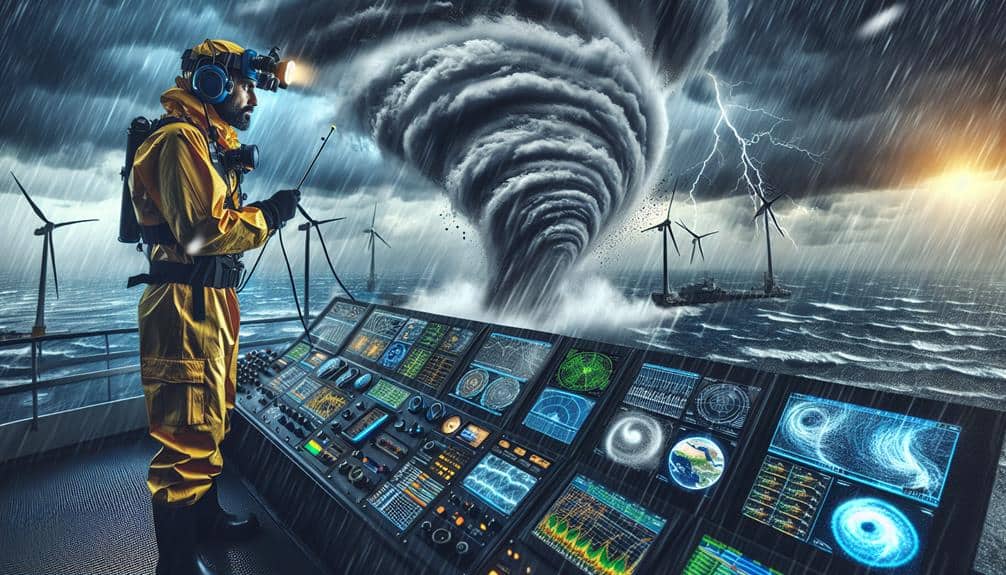When pursuing hurricanes, we must prioritize safety with five key practices. First, equip ourselves with industry-standard safety gear like helmets, waterproof attire, steel-toed boots, goggles, and gloves. Second, monitor weather updates from trusted sources, integrating radar data and maintaining an emergency supplies checklist. Third, meticulously plan multiple evacuation routes, utilizing GPS and avoiding flood zones. Fourth, guarantee reliable communication using devices and apps to keep regular check-ins and share real-time locations. Finally, understand storm behavior by mastering storm tracking, analyzing satellite data, and studying past trends. By adhering to these measures, we maximize our safety and preparedness.
Key Points
- Equip with industry-standard safety gear, including helmets, waterproof clothing, and steel-toed boots.
- Monitor real-time weather updates from reliable sources like the National Hurricane Center.
- Plan multiple evacuation routes and use GPS for live traffic and flood zone updates.
- Utilize reliable communication devices and establish regular check-in intervals with emergency contacts.
Equip Proper Safety Gear
To secure our safety while chasing hurricanes, we must equip ourselves with proper safety gear that meets industry standards. Our first line of defense involves a well-thought-out selection of gear essentials. We need helmets that can withstand high-velocity debris, guaranteeing head protection.
Durable, waterproof clothing is essential to prevent hypothermia and maintain core body temperature. Let's not forget sturdy, steel-toed boots, which offer both foot protection and stability in uneven terrains. Safety goggles are vital to shield our eyes from wind-driven particles.
We should also carry gloves that provide both dexterity and protection from sharp objects. Every piece of gear contributes to our overall safety precautions, minimizing risks during the intense conditions of a hurricane.
For communication, two-way radios with extended battery life are crucial. They secure we stay connected with our team, even when cellular networks fail. Additionally, a multi-tool can be a lifesaver for various emergency situations. Reflective vests increase our visibility, reducing the chances of accidents in low-visibility conditions.
Monitor Weather Updates
Equipped with our safety gear, we must continuously monitor weather updates to anticipate the hurricane's path and intensity accurately. Staying informed is essential for making timely decisions that secure our safety and effectiveness in hurricane chasing. Here's a precise approach to stay updated:
- Reliable Sources: Depend on authoritative sources like the National Hurricane Center (NHC) and local meteorological services. These provide real-time data and predictive models that help us stay ahead of the storm.
- Technology Utilization: Use weather apps with push notifications to receive instant updates. Integrate satellite imagery and radar data into our routine checks to visualize the storm's development.
- Frequent Checks: Schedule regular intervals to review weather updates. Hurricanes can change direction and intensity quickly, so frequent monitoring is vital to adapt our strategies promptly.
- Emergency Supplies Checklist: Keep a checklist of emergency supplies. This secures we've everything needed in case the situation escalates. Items like water, non-perishable food, medical kits, and communication devices should be ready to go.
Plan Evacuation Routes
When evaluating evacuation routes, we must carefully map out multiple options to ensure swift and safe egress under varying conditions. Analyzing potential pathways involves cross-referencing current road maps with real-time data on road closures and other obstructions that could impede our escape.
Our primary goal is to identify the most efficient routes that lead directly to emergency shelters, ensuring we have reliable places of refuge.
It's pivotal to use advanced GPS systems and mobile applications that provide live updates on traffic conditions, road closures, and weather patterns. This allows us to pivot quickly if our initial route becomes compromised.
We should also consider alternate routes that bypass high-risk flood zones and areas prone to landslides.
Redundancy is key. We can't rely on a single path. Instead, we need a minimum of three viable routes, each verified for accessibility to emergency shelters.
Coordination with local authorities and emergency management agencies can provide additional insights into temporary roadblocks or newly established safe zones.
Stay in Communication
Maintaining constant communication is essential for coordinating our movements and guaranteeing everyone's safety during a hurricane chase. Effective communication allows us to share real-time information, provide updates on our locations, and alert each other to emerging hazards.
Here are four key strategies to help us stay connected:
- Use Reliable Communication Devices: Equip ourselves with multiple communication devices such as satellite phones, two-way radios, and smartphones. These devices guarantee that we've various means to stay in touch, even if one fails.
- Establish Emergency Contacts: Before we set out, let's provide our itinerary and contact information to trusted individuals. These emergency contacts can relay information to authorities if we encounter trouble or lose communication with each other.
- Set Up Check-In Intervals: Regularly scheduled check-ins allow us to confirm everyone's status and position. By pre-determining these intervals, we can quickly identify if someone is missing or in distress.
- Utilize Communication Apps and Software: Use specialized apps and software to share our real-time locations and updates. These tools can provide detailed maps, weather updates, and instant messaging capabilities, making our coordination more efficient.
Understand Storm Behavior

Understanding storm behavior is essential for our safety and success as hurricane chasers. We need to master storm tracking to anticipate a hurricane's path accurately. By analyzing satellite data and radar imagery, we can predict the storm's trajectory, enabling us to position ourselves safely and efficiently. It's vital to monitor real-time updates from meteorological agencies, which provide necessary insights into storm evolution.
Wind patterns are another critical aspect we must consider. Hurricanes are characterized by complex wind dynamics, including the eye, eyewall, and outer bands. Understanding these patterns helps us determine the most hazardous zones and the safest areas for observation. The eyewall harbors the most intense winds, while the eye is deceptively calm. By recognizing these features, we can better navigate around potential dangers.
We also need to study past storm behaviors to identify trends and anomalies. Historical data provides a framework for understanding how similar storms have behaved, which can inform our current strategies. By combining historical insights with real-time data, we enhance our ability to predict and respond to changing conditions.
Ultimately, our grasp of storm behavior ensures we chase hurricanes with both freedom and safety in mind.
Frequently Asked Questions
What Are the Best Practices for Documenting Hurricane Data?
To document hurricane data effectively, we must prioritize data collection accuracy and adhere to strict safety protocols. Using reliable instruments and staying within safe zones guarantees our data is precise while maintaining our freedom to explore responsibly.
How Can I Prepare My Vehicle for Hurricane Chasing?
To prepare our vehicle for hurricane chasing, we'll prioritize vehicle maintenance and guarantee our storm equipment is secure. Let's check tire pressure, fluid levels, and pack essentials like GPS, first aid kits, and high-quality weather instruments.
What Are the Legal Considerations for Hurricane Chasers?
Like modern-day Prometheus, we must navigate the storm wisely. Legal considerations include ensuring our insurance coverage is thorough and understanding liability concerns. We should confirm we're not violating any local laws or impeding emergency services.
How Do I Manage Stress and Mental Health During a Hurricane Chase?
To manage stress and mental health during a hurricane chase, we should prioritize stress management and self-care. Implementing coping strategies like deep breathing and regular breaks guarantees we maintain our mental health while pursuing our passion for freedom.
Are There Specific Community Guidelines for Hurricane Chasers to Follow?
Remember when we navigated that storm and saw the damage firsthand? Community safety and environmental impact guidelines are essential. We follow protocols to minimize harm, ensuring our passion aligns with ethical standards and respects local regulations.

